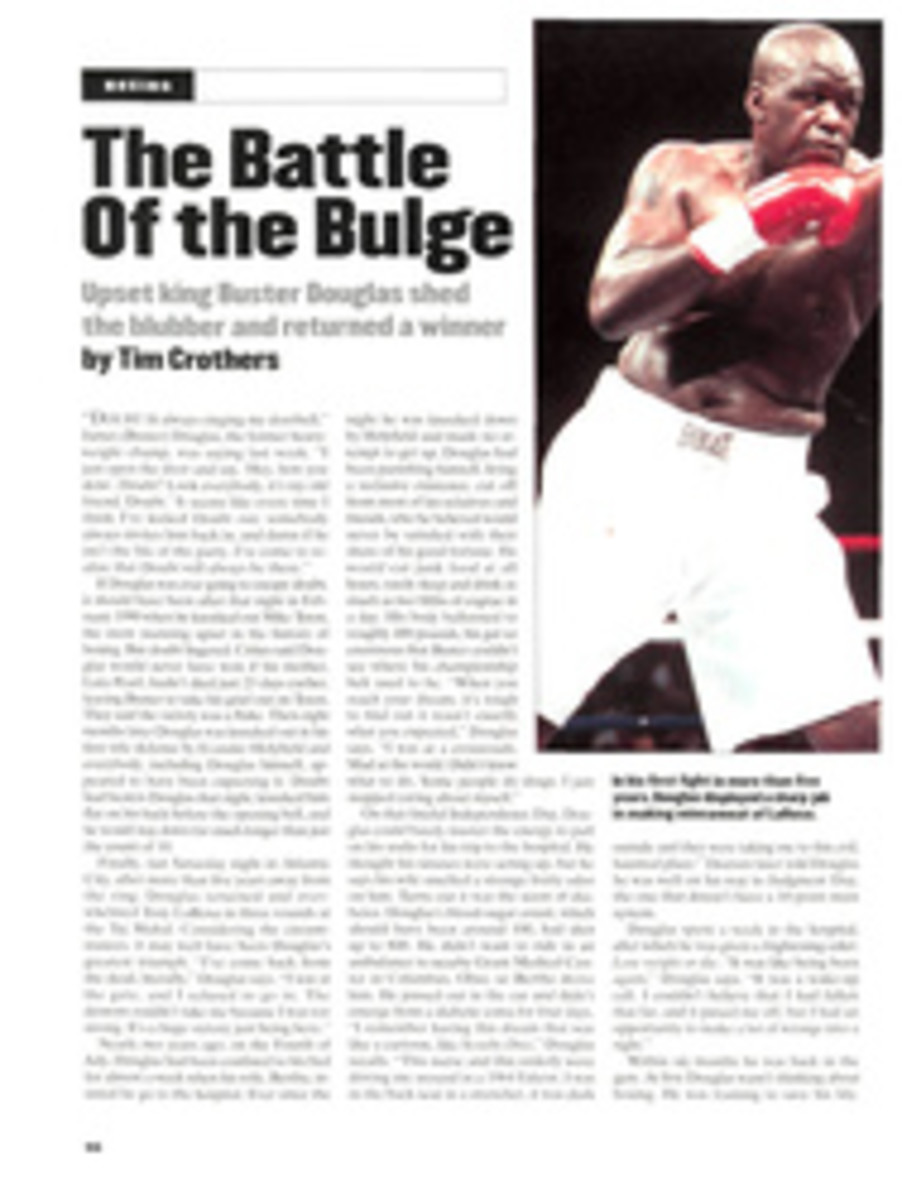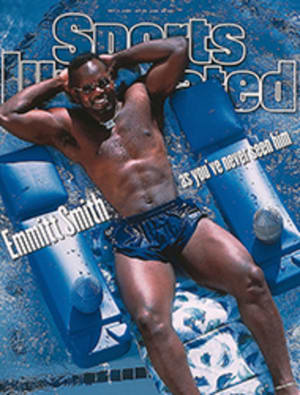
AS THE SEASON REACHES ITS MIDPOINT, THE BEST AND WORST OF 1996 U.S. CLOBBERED IN THE CURTIS CUP COOL SHADES
HALFWAY MEASURES
The 1996 golf season has reached the midway point, a perfect
time to take a look at some of the highlights and lowlights so
far this year. Let's go to the videotape.
Best Round Under Pressure. Nick Faldo's 67 at Augusta ranks with
the 67s shot by David Graham (1981 U.S. Open) and Ben Hogan
(1951 U.S. Open) among the finest final rounds in the history of
the majors. Faldo did not miss a fairway or a green. Still, his
play was overshadowed by the crash of Greg Norman.
Worst Wilt. See above.
Worst Wilt, Single Hole. John Daly rang up a 12 on the par-5 8th
during the second round of the BellSouth Classic in Atlanta.
Daly hit into the same creek twice and the second time tried to
play out, whiffing three times.
Best Nickname. "Lumpy," for Honda Classic winner Tim Herron.
Best Star Turn. Lee Trevino earned $40,000 for saying "Grizzly
Adams did have a beard" in Happy Gilmore.
Hottest Clubs. The Great Big Bertha driver and any putter made
by Odyssey.
Best Four Rounds. Turn to page G8 and read all about it.
Most Exciting Finish. Phil Mickelson went head-to-head against
Justin Leonard in overtime in the Phoenix Open, the first time
the former NCAA champs have squared off on the Tour. Mickelson
won on the third playoff hole, depriving Leonard of his first
pro win.
Most Disappointing. Bogeys on the last two holes of the U.S.
Open by Davis Love III included a three-jack from 18 feet at the
18th that kept him from forcing a playoff. How can anybody leave
that first putt short? But the next one, the downhill
three-footer, we've all missed.
Monster Years: Yes, Mickelson and Liselotte Neumann have three
wins each, but we're going with LPGA rookie Karrie Webb and Mark
O'Meara. They've got only two wins each but also a couple of
seconds, and they always seem to be in the hunt.
Car Wrecks: Billy Mayfair and Peter Jacobsen were among the top
10 on the money list a year ago. They're not even in the top 80
in 1996. Jacobsen has a bad back, but what's Mayfair's excuse?
Worst Call: David Eger, the Tour's head rules man, canceled the
AT&T Pebble Beach National Pro-Am because a single hole, the
16th at Spyglass, was unplayable on Sunday. The hole was fine
the next day.
Best Call: Jeff Sluman was only two strokes off the lead at the
Bay Hill Invitational when he phoned Tour official Arvin Ginn on
Saturday to say he might have made an improper drop the day
before. It was determined that he had, and the sportsmanlike
Sluman was DQ'd for signing an incorrect scorecard.
Happiest Ending: After 141 tournaments and what seemed like
1,411 missed three-footers, Tom Watson won again, at the Memorial.
AMERICA BASHING
Great Britain-Ireland's 11 1/2-6 1/2 whipping of the U.S. in
last week's Curtis Cup at the Killarney Golf & Fishing Club in
Ireland marked the second straight time that the British have
retained the Cup in the biennial match and, combined with the
sound beating the U.S. suffered in the Walker Cup last
September, completed a changing of the guard in amateur golf.
The shift in power can be traced to the migration of college-age
European players to U.S. campuses, where they have flourished.
"The days when British or European teams were in awe of the
Americans is past," says Mickey Walker, coach of the winning
Curtis Cup team. "The trend started with our players going to
U.S. colleges, where they have found that they can beat most of
the Americans. That confidence trickles back to the rest of our
players."
Two Scots who were also first-team All-America this year, Janice
Moodie (San Jose State) and Mhairi McKay (Stanford), led
Europe's charge last week. They were undefeated and earned 4 1/2
points between them.
America's brightest amateur hope, 18-year-old Cristie Kerr,
played well in Ireland, going 1-1-1 in the two-day competition.
But Kerr's first Curtis Cup was her last. She turned pro after
the event and planned to play this week in the LPGA's ShopRite
Classic in New Jersey.
THE HOLE STORY
It wouldn't be a U.S. Open if the players didn't whine about the
course, but there was an abnormally high number of complaints
about the pin placements at Oakland Hills. Here are a couple
suitable for the family.
"When I putted out on 18, I had to look in the cup to make sure
the ball wasn't going to go underground to the pro shop," said
John Huston. "I kept hitting the windmill, and it kept kicking
it back out."
Said Mark O'Meara, who had to play for 25 feet of break on a
40-footer he had on the 9th hole: "If I made that putt, I should
have gotten a free game." (Not to worry. O'Meara four-putted.)
Does this after-the-fact complaining do any good? Maybe. A move
is afoot among Tour players to have some of their rules
officials help a five-person USGA committee set the pins at
future Opens. At least one member of the committee, Tom Meeks,
the director of rules and competitions, is willing to consider
such a change. Meeks admits that one of his placements, the 17th
on Thursday, was unfair. But he adds that 95% of the pins at
Oakland Hills were no different in 1996 than in 1985.
"I can take the potshots, and I can take the heat," says Meeks.
"That's what you have to do when you're in this position. But I
think if the PGA Tour field staff would have set them, they
would have received the same criticism. Those were the hardest
greens in the world to set holes on. I thought we did as good a
job as we could with a difficult golf course."
COLOR PHOTO: JACQUELINE DUVOISIN Jacobsen won more than $1 million in 1995 but has had nothing but trouble this season. [Peter Jacobsen]
COLOR PHOTO: ALLSPORT Kerr celebrated her graduation from high school by playing in the Curtis Cup then turning pro. [Cristie Kerr]
COLOR PHOTO: ROBERT BECK Duval used to stand out in his sunglasses. [David Duval wearing sunglasses]
MADE IN THE SHADES
What do U.S. Open champions Steve Jones and Annika Sorenstam
have in common? They wear sunglasses, something you would never
have seen on a pro golfer five years ago. Today, everyone seems
to be wearing a pair of Oakleys, Ray-Bans or Bolles. "I used to
be called a rebel," says David Duval, 24, who as an All-America
at Georgia Tech was one of the first players to make shades a
part of his golf uniform. "Now you've got 25 or 30 guys wearing
'em."
Mainly younger players go for sunglasses. Several veterans think
that's because the kids have something to hide--namely, fear.
Pat Bradley, for example, says she is unable to read the eyes of
a player wearing shades, and that takes away one of her
advantages. The sunglasses set, however, doesn't buy into that
theory, insisting shades simply make it easier to see. The newer
models no longer distort depth perception, a problem with shades
in the past. And optical companies are now designing dark
glasses specifically for golfers. "The reason I wear them is
that I squint a lot in the sun and get headaches," says
Sorenstam. "When you squint, you tense up. Sunglasses keep me
relaxed. Plus, you definitely see better at times, especially in
a bunker, because the sun reflects off the sand. There's no
glare." Jones also turned to eyewear to combat squinting.
There are other concerns that make sunglasses a wise choice.
Duval and Emlyn Aubrey, among others, wear contacts, and
sunglasses keep their lenses from getting dry or dusty. Karrie
Webb went to Oakleys because, she says, a friend in Australia
contracted eye cancer from too much exposure to the sun. Also,
Webb is trying to protect against crow's-feet around her eyes.
And then there is the matter of endorsement deals. Most players
are given free sunglasses, but Sorenstam is paid to wear them,
which explains why the two-time Women's Open champ keeps them on
the bill of her cap when the sun goes down. --T.R.

